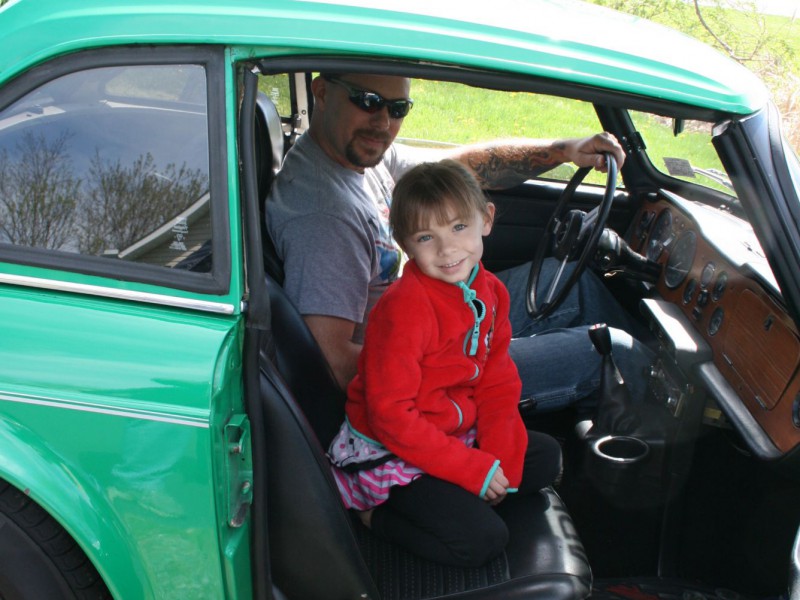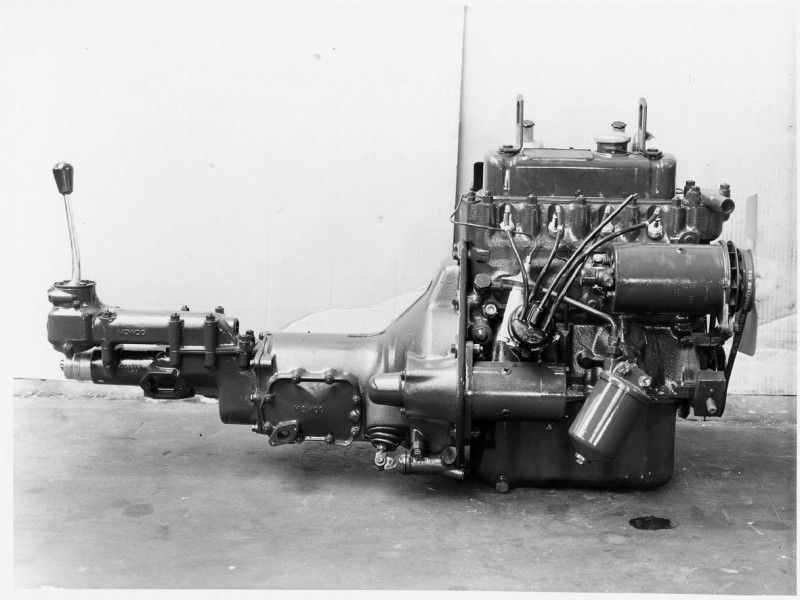By Brian Smith
As a young boy I had an artistic ability and was constantly drawing. The rest of my free time was usually spent in the garage with my Dad wrenching on vintage British sports cars. There were Triumphs, MGs, Jaguars, and Minis overflowing our garage and onto the driveway at any given point of my childhood.
Being a car guy with the same gasoline in my veins as my father, my drawing naturally gravitated towards cars as the subject. I read every car magazine I could get my hands on and loved seeing new concepts. My bedroom was filled with posters of primarily European supercars, then one day I distinctly remember changing out the Ferrari 308 GTS poster I had with one of the new 1984 Corvette. I couldn’t believe it was an American design. So dramatically proportioned yet so clean and simple. The clamshell hood that exposed the fat tires and suspension was an awesome sight. I was 11 years old and decided right then and there that car design would be my profession. Later, in college I found out how competitive and specialized the field actually is. There are fewer car designers in the USA than there are NBA basketball players, to put it into perspective. I had to work extremely hard to get summer internships to refine my craft with the help of the professional designers. I completed my final internship at General Motors in 1994 and, after graduating the following year, I’ve been there ever since.
Even though much of my world is focused on American cars, my entire adult life there has always been at least one vintage British car in my garage, including my first car that I bought with my own money—a ’67 Triumph TR4A that is currently undergoing a complete restoration.
Not long after I joined GM Design, I met my wife Jen. An overseas assignment led us to Trollhattan, Sweden, working at Saab, and my first son Connel was born there. I couldn’t take my cars with me, and soon after getting there the urge to have another British car led me to purchase a ’74 Austin Mini 1275 GT. We later brought the car home to the US with us.
Over the next five years, we had two more boys, Cormac and Ian. While my wife was pregnant with Cormac, I was working some very long days on the 2003 Cadillac Sixteen Concept car—a V16 powered hyper luxury sedan with 1000 horsepower. It earned the Concept Car of the Year award in 2003, one of the highlights of my design career. In 2007 I was asked to go on assignment in the UK to manage our advanced design studio there and we jumped at the opportunity. It was here in Coventry, very near the Jaguar technical center, that we designed top-secret internal projects primarily for Cadillac. The final result of my tenure there was the Cadillac Converj concept car. The family enjoyed every moment of living there and we travelled as much as my job would allow.
While in England, I purchased another Mini, this time RHD, and I installed a supercharger on it. I was able to really enjoy some of the B roads in that one, which we also shipped home at the end of the assignment.
My career at GM has been exciting and fruitful. I’ve had the honor of working with some of the most talented women and men in the business on some truly stunning automobiles: 2006 Camaro Concept, 2014 Cadillac CTS, and the 2017 Cadillac XT5.

Owning a Time Capsule
Time has flown by and a handful of interesting cars have come into our possession and gone, but in the spring of 2014 we purchased the crown jewel of our collection—a 1954 Austin-Healey 100.
You don’t have to be a car designer to appreciate the beauty of a Healey 100. The extreme cab-rearward proportions, dramatic curves, tight cockpit, and that fantastic lay-down windshield always manage to captivate onlookers. Our Healey 100 BN1 has been owned by two car designers in its whole life, including me. We bought it from its original owner, who bought the car in Indiana in 1954 for $3020 while he was designing cars at Studebaker for Raymond Lowey. He only managed to put 25,000 miles on it in 60 years of ownership, but he clearly cherished it, maintained it lovingly, and kept it out of the elements for its entire existence. The car was not advertised, instead I found out about it from a co-worker who saw it in a garage in his neighborhood under a cover. The day I bought it, I sat for more than an hour talking with the previous owner about the Healey, cars and design in general. Turns out the gentleman that I bought the car from actually worked alongside Gerry Coker (the man who penned the Healey 100) while at Chrysler Design in the late ’50s. It also became obvious how fastidious and meticulous he was about his car. I received a crisp, new-looking 1958 title for the car after payment. I received a stack of oil change and service receipts dating back to 1954, along with the original tool kit, Shelley jack, and hardbound owner’s manual. I drove the car home on a crisp cool spring morning on its factory-original Dunlop Road Speed bias-ply tires!
I’ve always enjoyed the look of the big Healeys. They have perhaps the most dramatic proportions of any mid-50’s sports cars. The impossibly long hood works so well with the low, short tail and gentle curve of the body side. Front overhang is almost non-existent. The lay-down windshield gives the car the ultimate profile and low stance. Inside it is pure function—bare bones, but still absolutely beautiful. Sitting in the car, you get the feeling of being in a vintage airplane, so strong is the wrap-around feeling of the hollowed out doors and body color steel dash. I particularly love the simplicity and cleanliness of the BN1 100s with their color-matched interiors, smaller front wheel arches, and lack of rear lamp reflectors. The unique shield-shaped grille also sets the 100 apart from the other Big Healey models that followed. It is amazing to me that a car as beautiful as the Healey 100 was never created in a full-scale model before the panel bucks were created. The Tickford craftsmen created the body solely from blueprints.

This particular Healey 100 oozes originality—from the soft patina of the original lacquer, to the aged green leather of the seats. Even the smell is intoxicating: old leather mixed with the slightest hint of fuel and oil. I even like the period accessory choices the previous owner made, like the aluminum valve cover he bought for $20 new in 1958, and the wonderful driving lights that necessitated removal of the over-riders (which were wrapped in newspaper and stored for 50 years). There is also a neat clamp-on rear view mirror on the drivers’ wing edge that didn’t require any drilling of the bodywork yet looks perfectly at home on the car. Amazingly, even the chrome is in such good shape that you would assume it was re-done less than 10 years ago. The factory paint still shows over most of the underside with only hints of slight surface rust here and there.

Given that this car has never been restored or disassembled in any way, it drives like a very lightly used Healey must have in about 1956. It has a solid, complete, and genuine feel about it. It goes down the road wonderfully on its new wire wheels and Vredestein Sprint radials (I bagged the original set, which were no longer true or round, and stored them in my basement). Having never previously owned a Big Healey, I always imagined one would drive like a TR3 or MGA. Those perceptions were wrong as I found that the 100 drives with a much more sophisticated feel—lighter steering, nimble and planted, and with a fairly stiff chassis that doesn’t flex much at all. The huge four has an abundance of low-end torque, providing strong acceleration for a car of that era. Now I just need a set of goggles so I can leave the windscreen down all the time.
I would rather have this Healey than a perfectly restored example. Owning it feels like winning a special British car lottery. Like they say, they are only original once.









'The Art of Being an Original' have 3 comments
November 21, 2017 @ 8:04 am Dave Howe
Great article …interesting story about a cool car guy and his very special car!
I learned things about the big Healeys I never knew and appreciate them more than ever.
I’m an MGA guy but I almost bought an Austin Healey once…neat car, low miles, perfect mechanical condition, great price! And lay-down windscreen. But the poor baby had been badly beaten all-over in a West Texas hail storm and I knew I could not fix it, or live with it, as-is. I had the Brit sports car bug though, which led to *almost* buying a new 1964 Jag XKE. But rare (for me!) good sense told me that it was not the car for a skydiving, motorcycle racing 21 year old on a very limited budget! This led to ordering a special 1965 Pontiac GTO, my favorite of all my long-gone cars.
Then as 23 year old newlyweds we bought a very-used 1955 MG TF1500. One of my fondest car memories is cruising the TF1500 on beautiful summer nights with cool, gentle breezes, hood and windscreen down and my beautiful 21 year old, blonde, sweet new wife smiling beside me. Nirvana.
Fast forward 51 years and we are still cruising those perfect summer nights in our restored 1959 MGA 1500 roadtser, missing only that wonderful lay-down windscreen!
Perhaps had I bought that murdered-by-hail Healey I would have stayed with that marque and lay-down windscreens.
Had I read read Brian’s well-crafted piece on his wonderful survivor at that time, I’m certain of it!
Thanks for the great ride, Brian…
May 1, 2018 @ 7:09 am JOSE MARIO GALVAO
209/5000
My 1959 MGA 1500cc central oil pump brake and clutch broke the cylinder coresondente the clutch. I already bought a repair kit After repairing the central pump, how do I get air out of the oil line?
November 1, 2018 @ 2:09 am Bryan Hall
Truely a feast for car afectianatos.